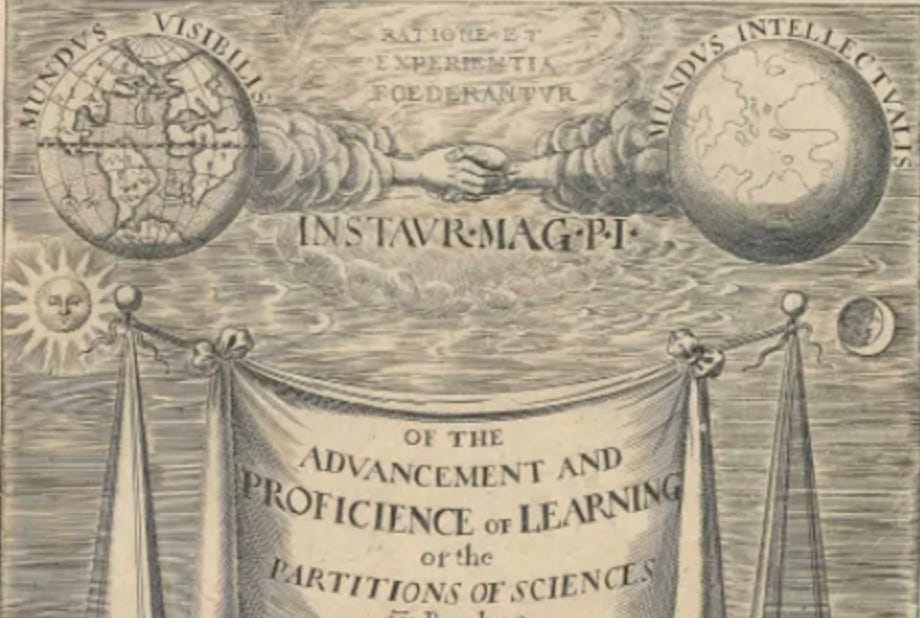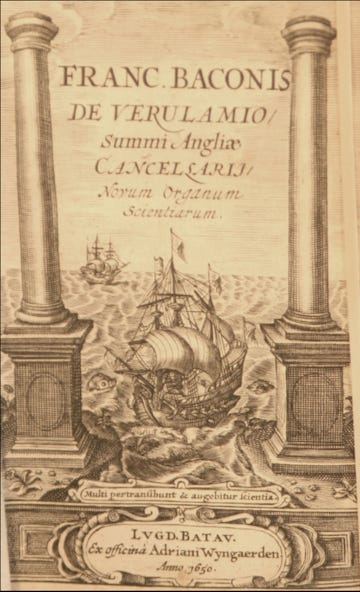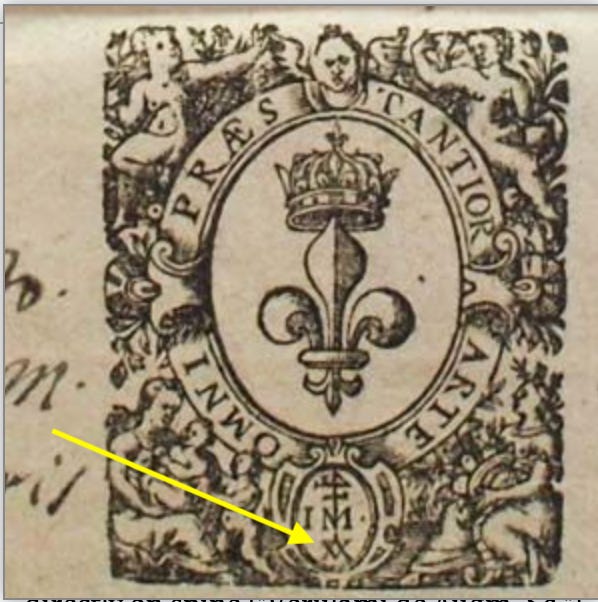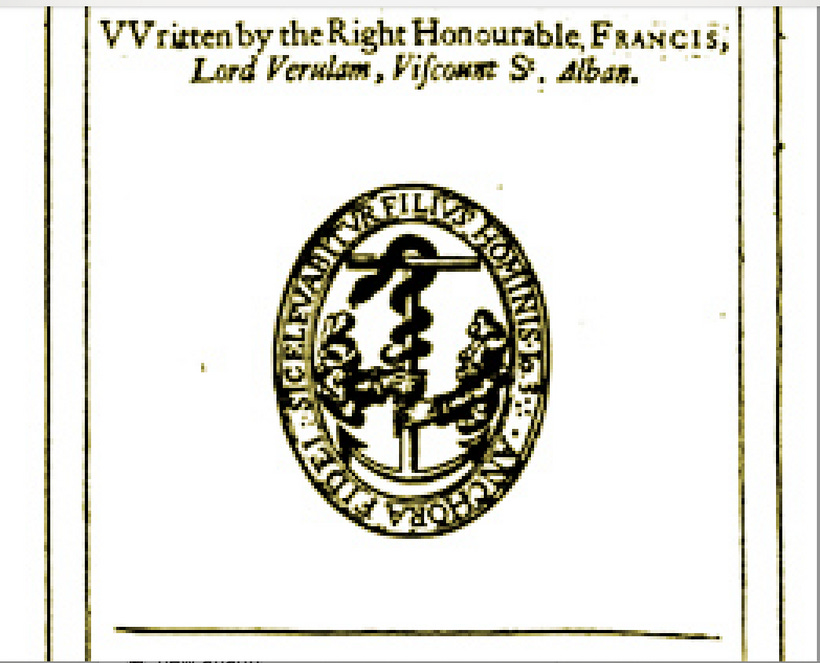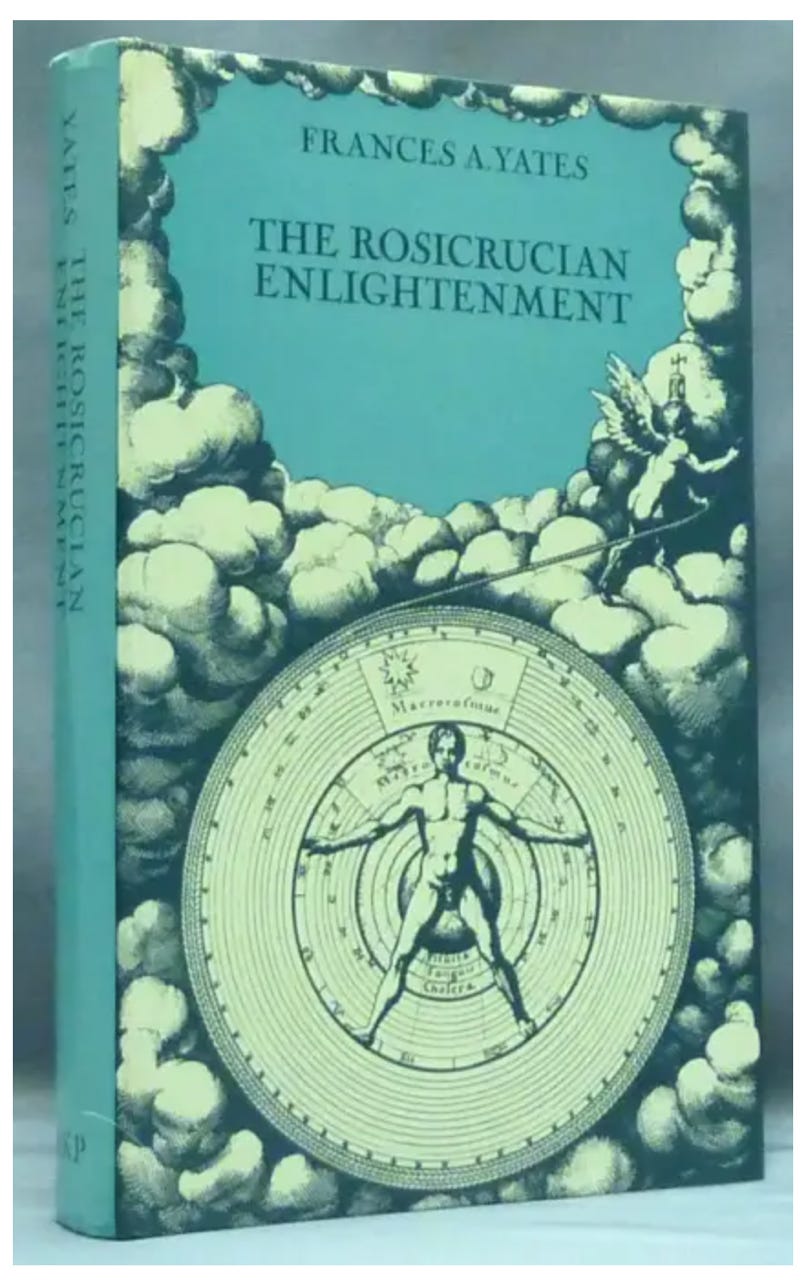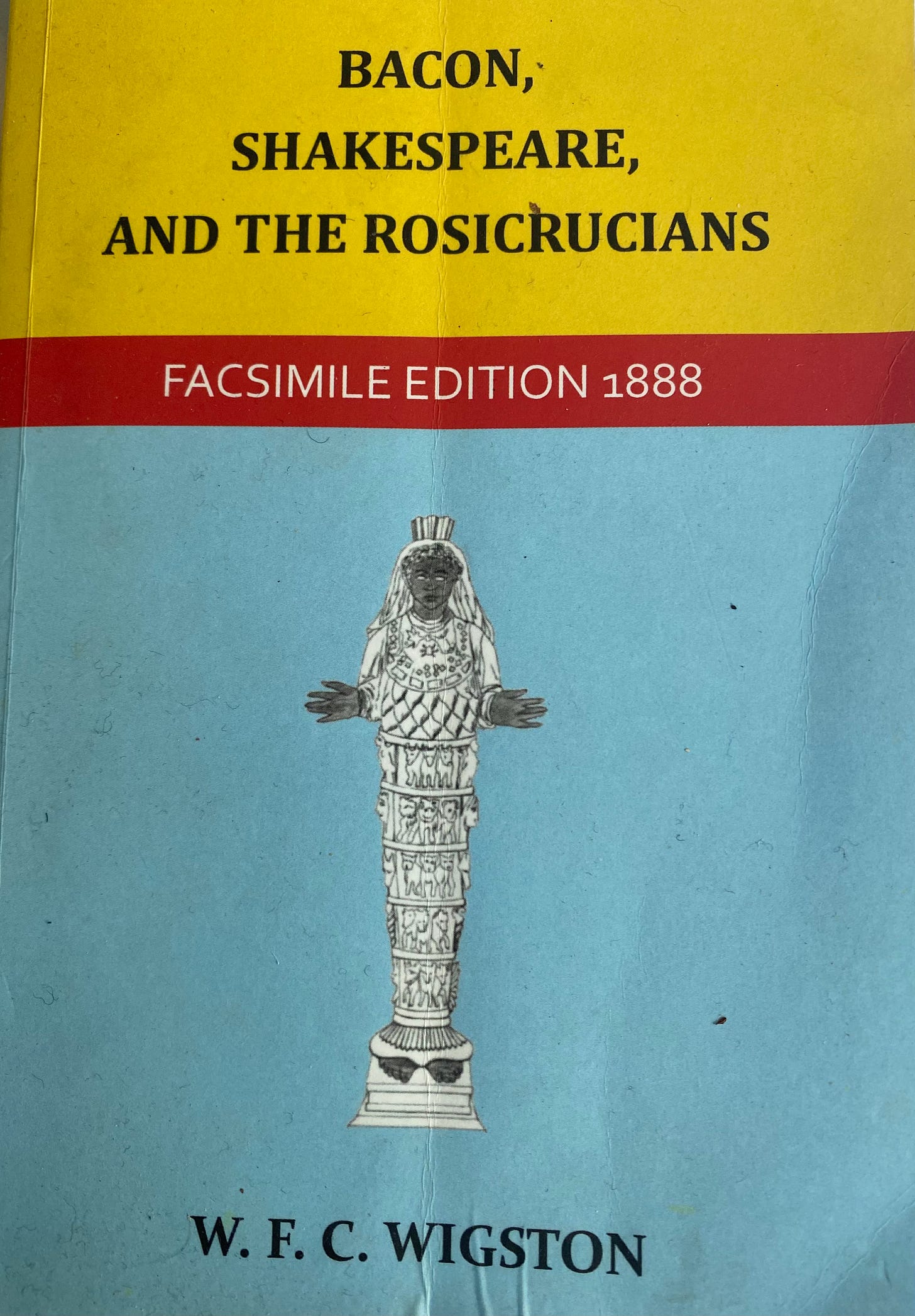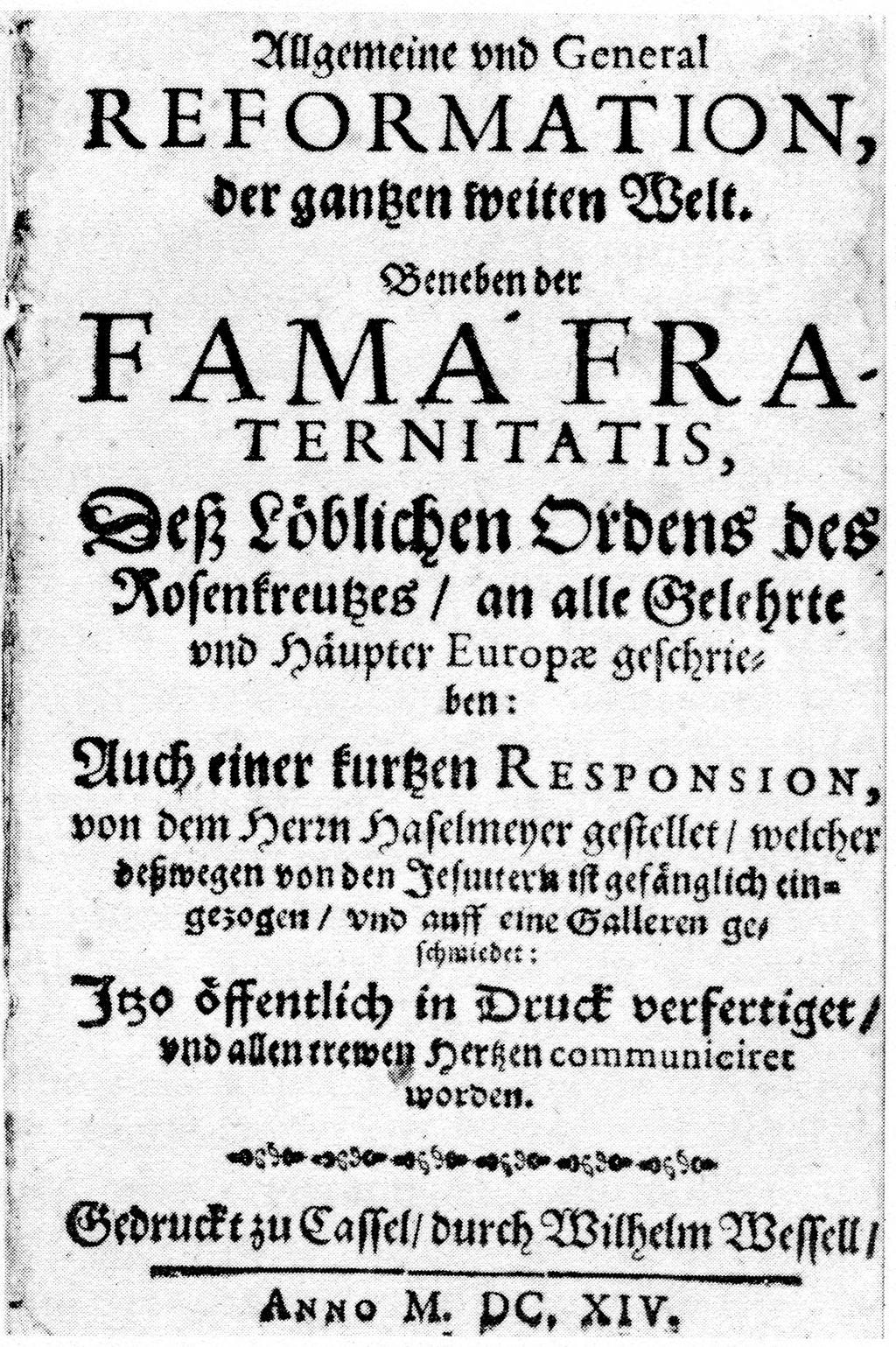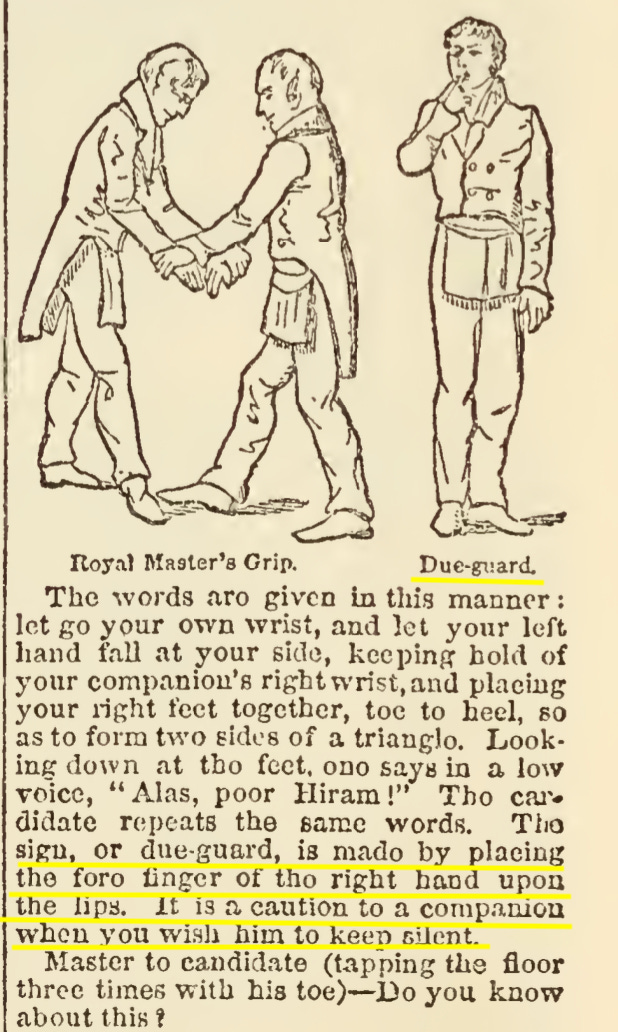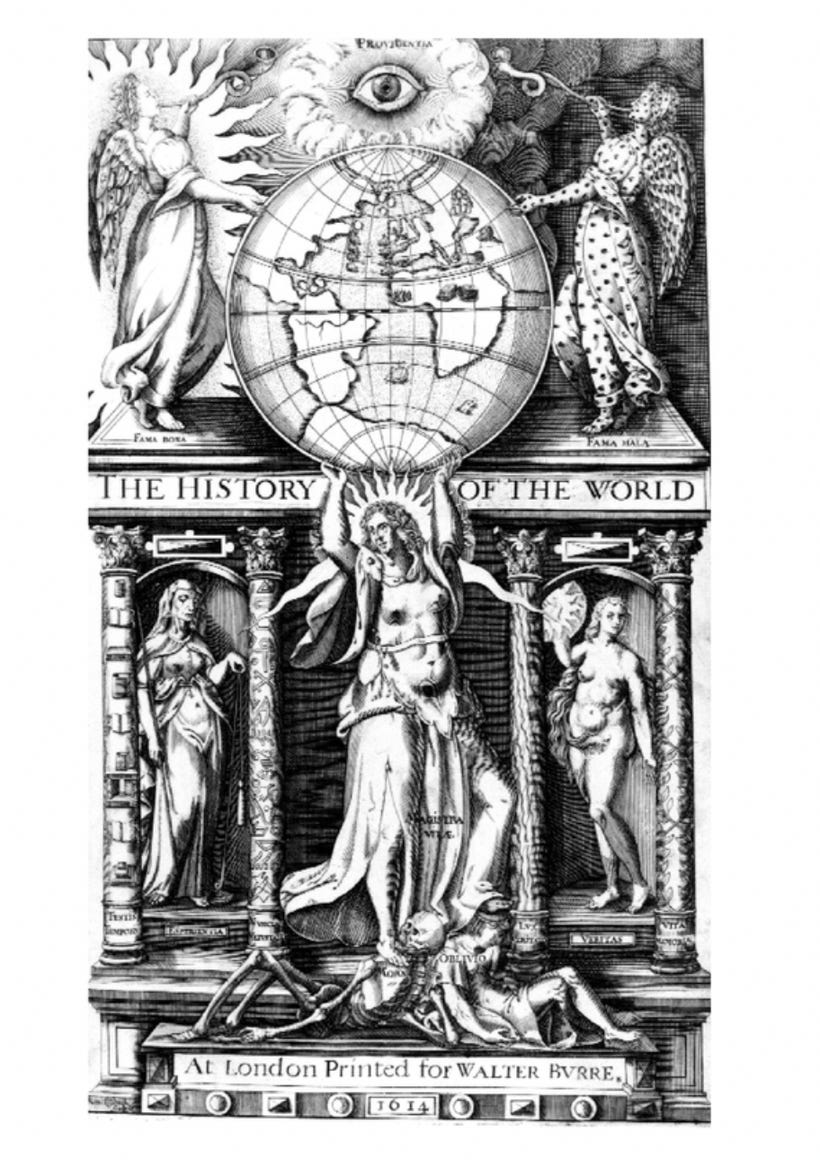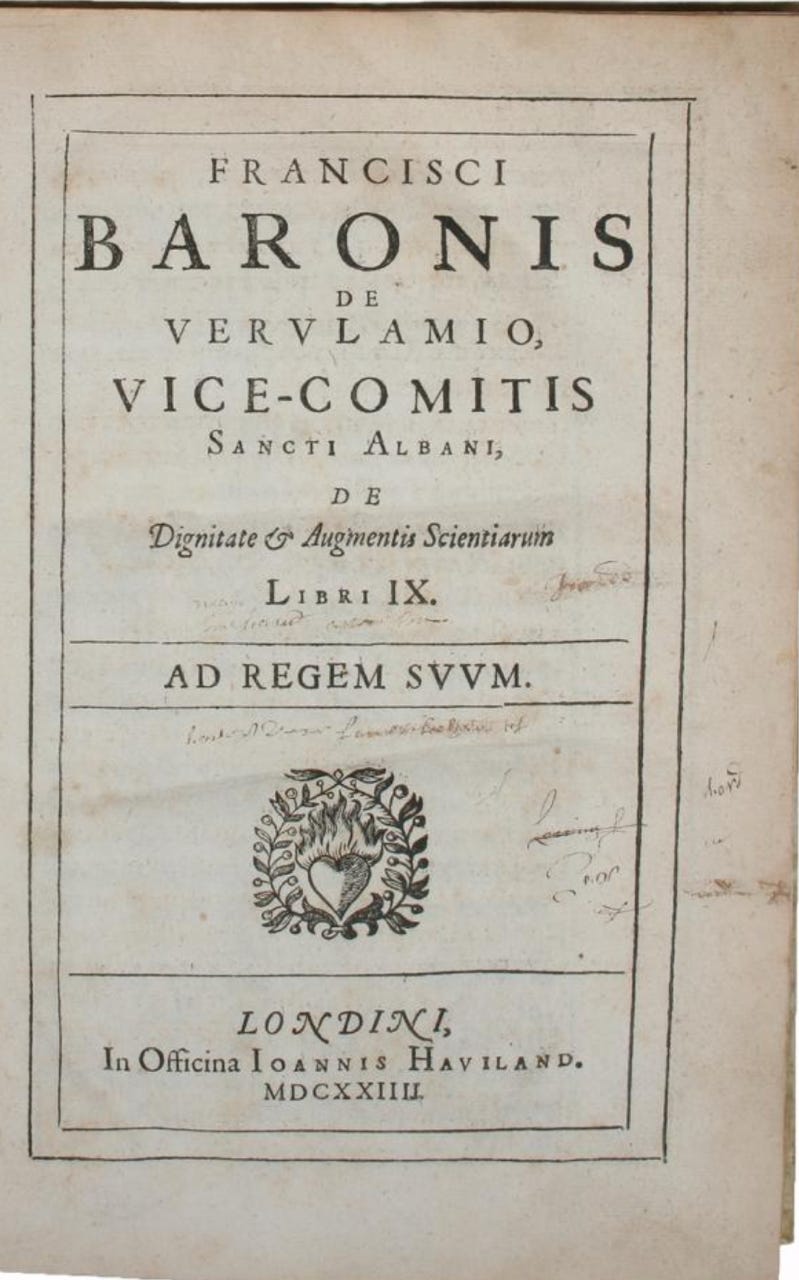Science And The Domination of Nature
I proposed…in my New Atlantis…that my Midnight Studies to make our Countries flourish and outvy European Neighbors in mysterious and beneficent Arts…my Ends are only, to make the World my heir~Francis Bacon in a speech given to Parliament 1620. (*1)
Read on Substack
Read on Patreon
Support This Work
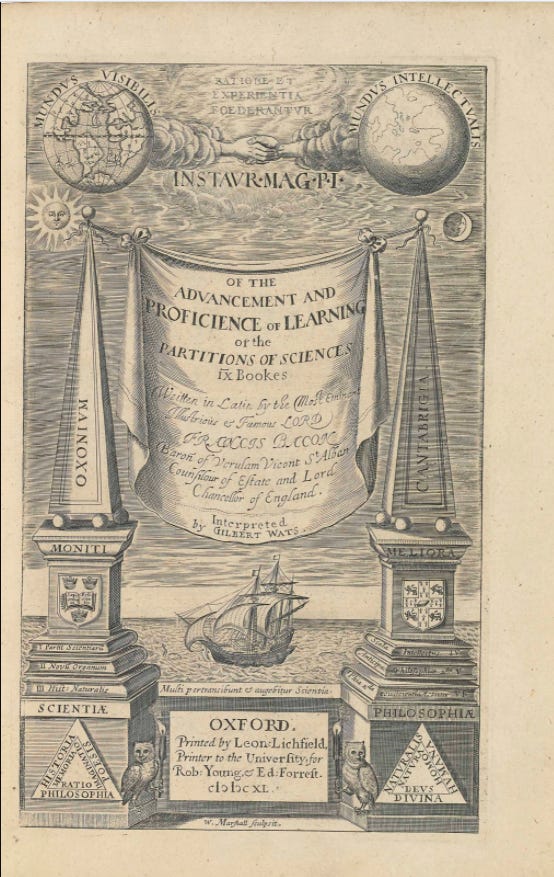
The Advancement And Proficiency of Learning, Francis Bacon 2nd ed. (1640)
(This is the second part of a series of essays presenting evidence that Francis Bacon created modern Freemasonry. Part 1 is here. For background see Francis Bacon, Science, Freemasonry, Shakespeare)
The Great Dissimulator: Bacon & The Rosicrucian-Freemasons
In 1605, Francis Bacon published the The Advancement of Learning, the first-ever book to promote the idea of a modern Science. An expanded edition was published in 1623, translated into Latin, entitled De Dignitate et Augmentis Scientiarum, aimed at the European intellectuals of the day, as the educated classes spoke Latin throughout Europe. The book made a tremendous and lasting impact. Bacon’s ideas were embraced by many prominent thinkers and mathematicians, including Descartes, Leibniz and others. (2)
In 1640 an English translation of the 1623 Latin edition was published. The frontispiece is pictured above and, in detail, just below.
Freemasonic symbolism saturates the imagery of the frontispiece from top to bottom only 14 years after Bacon’s death in 1626. Such a plethora of Masonic imagery in one image was otherwise non-existent in 1640, since the Freemasonic “brotherhood” did not officially exist yet, still being a secret society, not to announce itself for almost 100 years, appearing fully formed on the Summer Solstice, 1717 in London.
This grouping of Masonic imagery, when it does appear before 1717 is always associated with Bacon, as we saw with the intensely Masonic History of the Royal Society frontispiece featured in Part 1 of this essay. This grouping of Masonic imagery was nowhere to be found before Bacon’s publishing career began, and is part of the solid evidence we have that Bacon was central to the creation of Freemasonry. There’s plenty more evidence. For instance the central concept and imagery of Freemasonry is that of “light”, which appears in great profusion in the writing of Francis Bacon.
In Bacon’s 1605 Advancement of Learning, he wrote:
“And surely, as nature createth brotherhood in families, and arts mechanical contract brotherhoods in commonalities, and the anointment of God superinduceth a brotherhood in kings and bishops; so in like manner there cannot but be a fraternity in learning and illumination, relating to that paternity which is attributed to God, who is called the Father of illuminations or lights.”
This sentiment from 1605 is identical to the sentiment of the Rosicrucian manifestos of 164-1616 where the Rosicrucians describe themselves as a “fraternity in learning and illumination” focused on knowledge for mankind’s benefit, so similar to the Freemason brotherhood of “enlightenemnt” better for the puposes of charity and improving the world which is so similar to Bacon’s supposed purpose for the existence of his new science.
Between 1605’s Advancement Of Learning and the Latin De Augmentis appeared those mysterious “Rosicrucian Manifestos”. The manifestos were so expertly crafted, though published in German they caused a tremendous excitement throughout Europe.
The manifestos and their tales of a Rosicrucian brotherhood were a fabulist, mystical occult AND scientific literary hoax that yet contained a remarkable prophecy of a “general reformation of the whole world” based on Rosicrucian knowledge.
In that very same time period between 1605 and 1623 Bacon published his second groundbreaking philosophical work on science called Novum Organum (1620)
Novum Organum Frontispiece with Masonic Pillars, 1620
It so happens that 1623 is the very same year that the Shakespeare “First Folio” containing all 36 Shakespeare plays was published. The Shakespeare First Folio has been called the most influential book ever written in English! If so, then Bacon’s 1623 De Augmentis Scientiarum may be the second most influential book ever written in English.
Bacon wrote both of them and had them published in the same year.
In 1624 an edition of the 1623 De Augmentis was published in Paris, and the frontispiece also contains Masonic imagery- the very square and compass that was to become Freemasonry’s most prominent symbol.
De Dignitate and Augmentis Scientiarum, Paris, 1624
Within a generation after Bacon’s De Dignitate et Augmentis Scientiarum appeared, a new methodology for understanding the natural world took hold. It was a style of inductive reasoning, known as the “Baconian method”, described by Bacon as “true induction”, that has now become the standard methodology of scientists and thinkers to attempt an assessment of reality, replacing the more deductive and dialectical reasoning of Thomas Aquinas and the Scholastics then taught in all the universities. The “Baconian method” was devised specifically to create material progress, in order to to create a knowledge (scientia in Latin means both “knowledge” and “science’) not as abstract truth but as a knowledge of “usefulness”, to promote discoveries of the prime “inner workings” of things that would ultimately would allow humanity to "command" and "dominate" nature, to use Bacon’s words.
From Novum Organum’s introduction-“Human knowledge and human power meet in one”.
This was something new, a startling new goal for humanity; the idea of gaining knowledge that would allow man to dominate nature, marked a sea-change in the history of philosophy, and eventually in the aspirations of mankind. The ‘general reformation of the whole world’, trumpeted by the anonymous and mysterious Rosicrucian manifestos actually came true.
Remarkably, most of humanity has no idea that modern Science is organized as an effort to dominate nature.
Bacon accomplished his tremendous feat partially by a typical sleight of hand, using simulation and dissimulation, to be discussed later.
In De Augmentis Scientiarum Bacon discusses the purpose of his new method of scientific inquiry:
“The true end of knowledge is not to serve curiosity or ostentation, but to give a command over nature, for the relief of man’s estate.” (3)(4)
From Novum Organum, using typical Shakespearean antithesis, Bacon writes: “Nature to be commanded must be obeyed”. This sort of antithesis is often how Baconian dissimulation proceeds.
Also from Novum Organum:
“For if I should profess that I, going the same road as the ancients, have something better to produce”.
Bacon writes that the the ancients “wished to be like God, but their posterity wish to be even greater”. The difference for Bacon, in a nutshell, between him and “the ancients” (largely meaning Plato and Aristotle) was that unlike the “sinful”and “prideful” Greeks, his method would figure out how God did what he did, with respect, as his “true induction” would work with nature in order to gain her secrets, rather than impose mankinds ideas on nature. Bacon’s stated purpose was to return mankind to the condition of the Garden of Eden. Bacon aimed to redeem mankind by learning the secret of God scientifically. What he wanted was the wisdom and knowledge amongst the ancients before Plato and Aristote. the really ancient stuff he found via his study of the Greek myths, published in his Wisdom Of The Ancients.
These very same or similar notions were expressed in the Rosicrucian manifestos but in a fabulist, mystical and literary fashion. Between 1614 and 1616 two anonymous pronouncements were published and distributed all over Europe, containing the history, activity and structure of a secret brotherhood. They created a “furore”, particularly in Germany, France and the Netherlands. These manifestos, the Fama Fraternitatis and the Confessio Fraternitatis, created an “immense excitement".(5) They announced a soon-to-come era of vast advances in knowledge for mankind, the “General reformation of the whole world”. Incredibly, they were correct.
The manifestos were remarkably similar to Bacon’s philosophical books on Science but much more full of “magia and Cabala”, mysticism and legend.
The anonymous manifestos ignited a passionate interest in "Brother C.R.C.", Christian Rosenkreuz, whose body, the manifestos claimed, was buried in a hidden vault within the "House of the Holy Spirit”, where also was stored the Brotherhood’s vast knowledge and esoteric wisdom. The manifestos had clear links to mathematician, necromancer, cartographer and spy John Dee, Francis Bacon’s fellow London courtier.
The Rosicrucian manifestos were a highly successful hoax, but a hoax based on a truth. Not a single Rosicrucian was ever found, and the process of printing and distributing the manifestos had been done in secret in a Protestant area of Germany called the Palatine, where England, Francis Bacon and John Dee had a heavy presence. By coincidence, no doubt, the English flag happens to be a red cross and the Tudor symbol was a rose.
THE NEW ATLANTIS
To top it all off, in 1627 Bacon’s fictional science-soaked utopia New Atlantis was published. Although he had mentioned the book in his 1620 speech to Parliament, (see epigraph above) he waited until after he died to have it published. It was too risqué. King James was burning heretics and blasphemers in London as late as 1612. New Atlantis is another fabulist fiction, but this time illustrating in story how the new Baconian, useful science would create what at first blush, appears to be a utopia.
Early Edition of New Atlantis: Masonic Serpent and Tau Cross Symbolism
New Atlantis describes an island named Bensalem, unknown at the time to the entire world, yet an island that knew everything there was to know about the rest of the world via very sophisticated espionage. Bensalem, totally dedicated to Science, innovation and discovery as the story goes, was discovered by the English sailors who had been blown off course, or perhaps pulled off course purposefully by the great scientific powers of the Bensalem elites to bring the English sailors to the island who marvel at the ‘angelic’ powers of the scientists.
BY THE WAY, this plotline of New Atlantis is startlingly similar to the plotline of Shakespeare’s The Tempest, where a ship is purposefully pulled to an island to face Prospero the magician. The Tempest is the very first play in the First Folio.
The New Atlantis contains the first depiction of a technocracy, a society controlled by scientists and dedicated to science, where passive sheep-like inhabitants do the bidding of scientists who are carried around like kings. The scientists of Bensalem even have the power to create 'miracles'. This was no doubt where the story became to risqué to risk the wrath of King James.
The New Atlantis is so full of Rosicrucian symbolism, that a version appeared in 1662, (the very year Bacon Royal Society was chartered) called “Voyage To The Land Of The Rosicrucians” by John Heydon, that retells Bacon’s New Atlantis with an even larger Rosicrucian overlay.
anchora fidei sic elevabiture filius hominis-Anchor Of Faith So Will The Man’s Son Be Raised
The Encyclopedia Brittanica’s entry on Rosicrucianism:
“ Rosicrucian teachings are a combination of occultism and other religious beliefs and practices, including Hermeticism, Jewish mysticism, and Christian Gnosticism. The central feature of Rosicrucianism is the belief that its members possess secret wisdom that was handed down to them from ancient times.”
Freemasons, who also call themselves a brotherhood and a fraternity that seeks ‘light’ believe they also possess a secret wisdom dating back to ancient times, including the building of the Temple of Solomon, even claiming Euclid was a Freemason. The Bensalem scientists sent out surreptitious “merchants of light” to gather their knowledge of the rest of the world. The obvious connections between Bacon, Freemasonry, and Rosicrucianism pile onto one another repeatedly.
The Birth Of Transhumanism
The Rosicrucian manifestos even marked the birth of transhumanism with their declaration of the brotherhood's goal to end “old age”. Nature was to be dominated. Now where had we heard that before? Death and disease were to be fully overcome.
Dame Francis Yates' brilliant The Rosicrucian Enlightenment 1st edition 1972
A little known fact about Bacon is that he was heavily influenced by alchemy, magic and astrology, subjects that he has the reputation of liberating mankind from using reason, observation and Baconian induction. This notion was revealed to be false by Paolo Rossi’s seminal in-depth exploration of Bacon’s thought in Francis Bacon, from Magic To Science. Rossi spends a lot of time on Bacon’s work on the ancient Greek myths, and discovered that in reality what Bacon was after was a reform of alchemy and alchemists. Rossi teases out the influence on Bacon of the Renaissance philosopher-magician Heinrich Cornelius Agrippa, who also desired to return mankind to the prelapsarian condition, or ‘before the fall’ of Adam and Eve with his “Three Books Of Occult Philosphy” that are still in print. Rossi’s book on Bacon, first published in Italian in 1957, was translated into English in 1968 where it made a permanent impact on the study of the Great Dissimulator, “showing that it was out of the Hermetic tradition that Bacon emerged, out of the Magia and Cabala of the Renaissance as it had reached him via the natural magicians.”
General Reformation Of The Whole World
Astonishingly, soon would come the great and permanent changes in the world as prophesied, the origins of which have been traced to Bacon himself, who as mentioned has been labeled “the patron saint of the enlightenment”. Bacon in his own writing was “declaring that a new era in the history of humankind was at hand and that therefore traditional philosophy should be refuted”. How Rosicrucian can you get? (13)
Dame Frances Yates' phenomenal The Rosicrucian Enlightenment (1972) begins with Francis Bacon and his influence on the government of King James, whose daughter Elizabeth married Frederick V of the doomed German Heidelberg Palatinate, neighbors of the Hesse Palatinate from whence first came the Rosicrucian manifestos. Elizabeth and Frederick were known to be fans of Bacon’s philosophy of a new science. Bacon organized their wedding, even devising theatrical events for it.
Yates passed away in 1979 at the age of 80, after releasing her final book The Occult Philosophy in the Elizabethan Age. She repeatedly acknowledged Bacon’s connection to the Rosicrucians such as:
"... comparison of the Baconian movement with the Rosicrucian movement might be revealing for both, and particularly, perhaps, for Bacon.." (The Rosicrucian Enlightenment, Chapter 9, p 157)
“…struck by the idea that there might be a certain parallelism between the Rosicrucian and the Baconian movements, that these might be, so to speak, differently developing halves of the same problem, that it might be illuminating for both to study them together.” p 164
“The religion of New Atlantis has much in common with that of the Rosicrucian manifestos.” p 168
“This fiction sums up the work and aims of Bacon’s whole life, the advancement of learning to be applied for the use and benefit of mankind. This fiction…reflects at several points themes from the Rosicrucian manifestos in such away as to make it certain that Bacon knew the Rosencreutz story. p 164-165
Yates almost gets there, pegging Bacon’s sidekicks Sydney and Dee with starting Freemasonry, strangely leaving out Bacon:
“Let us suppose—purely as a hypothesis, a historical line along which future investigations might move—that it was in Elizabethan England that an idea of something like what was later the masonic idea had developed, in association with cults of the Queen and of the Dee movement, with which Philip Sidney was associated. In Elizabethan England…it seems likely that there would have been secret groupings.”
The imagery of ‘light’, secrecy, invisibility, Simulation and Dissimulation, advancement of knowledge and learning, the great reformation of the whole world, charitiy for the benefit of all mankind, these are all Baconian ideas that are Rosicrucian as well as Freemasonic.
In 1888 W.F.C. Wigston published Bacon, Shakespeare and The Rosicrusians. Yates trashes Wigston in The Rosicrucian Enlightenment:
"Wigston’s book is a typical product of that school of enthusiastic Baconian amateur scholarship which produces theories about Bacon and the Rosicrucians, or Bacon and Shakespeare, based on supposed ciphers and cryptograms, a school of thought which has brought much discredit upon the whole subject." (p. 61)
Yates is correct about the ‘supposed ciphers’ bringing ‘much discredit’ to the Baconian theories of Shakepseare authorship. She seems to lament the “discrediting! Was she interested in it but afraid to wade in? I think Yates knew the score about Bacon, Shakespeare and Freemasonry but just could not go there. The academy of her day would not have burned her at the stake for such heresy like a 20th c King James, but her life would have become very unpleasant had she broached the idea in writing.
The Silly Ciphers
Some of the work done with the Baconian ciphers has produced ridiculous results and I refuse to use them in my work, but that said, information is ciphered in some of the texts as Bacon was a master spy, and hiding (and deciphering) information in text was one of his tasks as a member and originator of British Intelligence. Bacon's disclosure of his ingenious cipher system in De Augmentis Scientiarum set off the later craze of “Baconians” deciphering secret messages they found Shakepseare by using the bi-lateral system.
Bacon, though did love hide and seek, there is no question about it. In a sense his inductive methodology is just that. A phrase he often repeats in his writings is:
“The glory of God is to conceal a thing, but the glory of a king is find it out, as if, according to the innocent play of children, the divine majesty took delight to hide his works, to the end to have them found out.” (14).
One of the most well known traditions of the Freemasons is their obligation as a brother to search for the “lost word”, which historian of Freemasonry, Freemason Albert Mackey descirbes as “being itself the very essence of the science of masonic symbolism”. The “science” of Masonic symbolism Albert???
Bacon took cryptography and ciphering to a whole new level in the Shakespeare plays.
Wigston goes well beyond alleged ciphers and cryptograms however and Yates does not acknowledge this other work. His level of scholarship is quite high if undisciplined, and he gathers an enormous amount of occult, magico-religious and mystery school correlations from Bacon to Shakespeare, the Rosicrucians and Freemasonry. Yates herself states:
“The question of Bacon’s possible connection with Rosicrucianism is a complex one, which cannot be fully resolved without much further research into the intellectual and historical currents of the time." (The Rosicrucian Enlightenment, p. 128)
In 1891 WFC Wigston published Francis Bacon, Poet, Prophet, Philosopher, Versus Phantom Captain Shakespeare The Rosicrucian Mask where he provides some of that research that Yates said was needed.
"The Rosicrucian manifestoes, the Fama and Confessio Fraternitatis, published in 1614 and 1615, bear the unmistakable stamp of Bacon’s mind, their style and purpose mirroring the speculative and reforming spirit of his New Atlantis and his philosophical works, which seek to advance learning and unite mankind under the banner of truth."
Enter Stage Left: The Remarkable Mary Constance Pott
Amongst the British Museum’s archive of Lord Francis Bacon’s papers, James Spedding, editor of The Complete Works Of Francis Bacon, discovered a notebook called the Promus of Formularies and Elegancies that contained, in Bacon’s own handwriting, hundreds of phrases that are found in the Shakespeare plays.
The Promus of Formularies notebook, discovered in 1867, is conclusive evidence that at the very least, Lord Francis Bacon, Baron Verulam, Viscount St. Alban was involved in writing the Shakespeare plays.
James Spedding published The Complete Works of Francis Bacon in fourteen volumes between 1857 and 1874, not mentioning the startling fact that the Promus Notebook contained hundreds of phrases found in the Shakespeare plays.
But someone did mention The Promus and in a very loud voice. The remarkable Constance Mary Pott (1833-1915) published a book in 1883 entitledThe Promus of Formularies and Elegancies, where she publishes the Promus, drawing attention it’s remarkable concordance to the Shakespeare plays and analyzing it’s significance for proof not only of Bacon’s contribution to the authorship of the Shakespeare plays but also for his connections to the mysterious Rosicrucians. (7*) Yates never mentions her.
Two years later, Pott (the mother of 11 children) published her second book, Francis Bacon and His Secret Society, where she argues that Freemasonry in its modern form emerged in the Elizabethan era under Bacon’s influence, with his philosophical and esoteric writings providing it’s intellectual foundation.
The Francis Bacon Society
Pott’s evidence is drawn by exposing clear thematic parallels between Bacon’s works and Masonic principles, parallels also clearly seen in the Shakespeare plays. She then started the Francis Bacon Society in 1886. The Society is still putting out high quality scholarship with evidence piled on top of evidence Bacon as the true author of Shakespeare in their journal Baconiana. Every issue of the journal, 150 years worth, is now on-line.
Francis and Anthony Bacon
Pott cites Bacon’s close relationship with his brother Anthony Bacon and their activities at Gray’s Inn law school, where they lived together, and where they organized intellectual and theatrical events. Francis’ brother (or foster-brother) Anthony Bacon was a professional spy his entire life and played an extremely important role in Francis Bacon’s life. Francis was in charge of the Revels at Grays inn for many years. The Revels were 12 day long Christmas celebrations that included plays and masques.
Earliest Performance Of Shakespeare
Gray’s Inn law school is the is the earliest documented location where a public performance of a Shakespeare play ocurred. It was put on by Francis and Anthony Bacon at the Christmas revels of 1594. (8*) Bacon kept a suite of rooms at Gray’s Inn his entire life after graduating law school, living there for a time with Anthony. The Bacon brothers also put on theatrical events called “masques’.
The Earliest Masonic Lodges
Pott suggests these gatherings were early Masonic lodges, citing the secretive and ritualistic nature of the plays. Pott details the Freemasonic ideology that permeates the Shakespeare plays as well as the writings of Bacon. For more on the thematic parallels in Bacon’s writing and the Shakespeare plays see The Overwhelming Evidence That Bacon Wrote The Shakespeare Plays.
Pott delves into other clues that are found in paper-marks and printing practices that expose Bacon’s connection to a secret society. She is hardly alone in this assertion. (9*)
The First Roscrucian Manifesto- The Fama Fraternitatis 1614
The Rosicrucians Were The Early Freemasons
Thomas De Quincey published Historico-Critical Inquiry into the Origin of the Rosicrucians and the Free-Masons in 1824, one of the earliest attempts to link Rosicrucianism and Freemasonry. DeQuincey:
“I affirm, as the main thesis of my concluding labours, that Freemasonry is neither more nor less than Rosicrucianism as modified by those who transplanted it into England. (Collected Writings, Vol. XIII, p. 421)
Tobias Churton, a modern apologist for the occult, wrote the Invisible History of the Rosicrucians (2009) where he argues that Rosicrucianism’s emphasis on spiritual transformation and secret knowledge influenced the development of Freemasonry, particularly in the 18th century when Rosicrucian-inspired degrees were incorporated into Masonic systems.
“Freemasonry, a tradition that owes a great deal to the lines of thought and tradition dubbed “Rosicrucian”.”
Evidenced by the similarity of symbolism, intent, and philosophical outlook of the 1605 and 1623 Advancement and the 1620 Novum Organum, multiple writers have gone on record to state the obvious that the Rosicrucian Brotherhood was simply Francis Bacon. They then go further and state that the Rosicrucians were in fact still-secret brotherhood of Freemasons who were 100 years away from going public.
Frederick Nicolai 1733-1811
But even before Pott there was Frederick Nicolai 1733-1811, who detailed how the Royal Society, Bacon’s inspiration, was fueled by Freemasonry, and was heavily influenced by the Knights Templars. Nicolai’s book has not been fully translated, but some parts have been, and he lays the origin of Freemasonry squarely at the feet of Francis Bacon, again largely using New Atlantis.
Freemasonry and The Royal Society are deeply linked as we explored in Part 1 of this essay.
In my favorite book on the Gnostics, “The Gnostics and Their Remains” by Charles William King, published in 1887, King, the great scholar of Gnosticism and the history of religion writes:
“Besides these obligations to the Rosicrucians, the London Freemasons also borrowed much of their phraseology from Lord Bacon's work, still fresh in men's minds, in which, adopting the idea of the "House of Wisdom," a technical term with the Arab astrologers, he proposed the foundation of a "Solomon's House," or learned community dedicated to the cultivation of experimental philosophy and the advancement of science. These philosophic and royalist plotters, in order to cloak the true nature of their proceedings, conducted, their conclaves according to the rules prescribed by Bacon: and the same ceremonial and nomenclature they carefully maintain to the present day.”
The Scottish Connection
Recent research has revealed that Freemasonry emerged in Scotland during the reign of King James VI. What hasn’t been revealed until now are the extensive connections of Francis and Anthony Bacon to that coming together.
Anthony Bacon provided connections to Scotland and to King James via his official position in English intelligence at its very origin under Francis Walsingham. Part of Anthony’s work involved secret contacts with King James in Scotland. His letters are part of Calendar of State Papers, Foreign, Elizabeth, 1558–1603 (SP 70–98) which detail Anthony’s European travels and intelligence work. They are also in the Calendar of State Papers, Domestic, Elizabeth, 1547–1603 which documents Anthony’s work with Essex and Scottish correspondence. The Calendar of State Papers, Scotland, 1547–1603 (Vol. 11–13) Records Anthony’s communications with Scottish agents.
It was in Scotland where the union of Francis Bacon’s symbolic language and deep knowledge of the human psyche gleaned from his extraordinary study of literature, first began to be melded with operative stonemasonry. Anthony Bacon was the go between. King James VI of Scotland (King James I of England) is considered to be the first Freemason.
“Simulation and Dissimulation”
In an essay entitled “Simulation and Dissimulation” Francis Bacon explores the need and ethics of lying. “Simulation and Dissimulation” is part Bacon's famous book Essays, his very first book published in 1597 when he was 37 years old. What had he been doing with all his time? Just one little book to show for it? Various editions of Essays were published over the course of his life. This small book had a profound impact on the English language, some arguing that it invented the essay form.
From Bacon’s essay ”On Simulation and Dissimulation:
“There be three degrees of this Hiding and Vailing of a Man's Selfe. The first, Closenesse, Reservation, and Secrecy; when a Man leaveth himself without Observation, or without Hold to be taken, what he is. The second, Dissimulation, in the Negative; when a man lets fall Signs and Arguments that he is not that he is. And the third, Simulation, in the Affirmative; when a Man industriously and expressely feigns and pretends to be that he is not.” (11*)
Confusing much? Spoken like a true master of espionage, Francis Bacon operated at the heart of early Intelligence before it was British, with Walsingham, Cecil, brother Anthony and the Earl of Essex. Historically, Freemasonry and espionage are strongly linked.
Induce A State Of Confusion In The Reader
Renowned literary critic Stanley Fish, in a book published in 1972 which is now considered groundbreaking and influential literary criticism, did an in-depth study of Bacon’s Essays. He states that what Bacon intended to achieve was to induce a “state of confusion in the reader” as a preliminary step towards them acquiring a more open and ‘scientific cast of mind'. (11*)
Confusion is a state where ideas can be planted in the subconscious mind. A classic technique of hypnosis is “the confusion technique”, and it was used during the Covid hysteria (a hysteria fostered by an irrational belief and trust in “science” as created by Bacon's legacy) by Big Media: the confusing barrage of scrolling information packed on the TV screen while the talking head delivered dire warnings and important 'science'-based messages straight to the innermost realm of the listener.
Have you ever noticed how confusing the Shakespeare plays are?
WRITING FOR ADEPTS ONLY: Secrecy Maintained
Bacon’s advocacy of secrecy in his own writing is well documented, and the core principle of Freemasonry is secrecy.
“For the art of ciphering hath for its end the concealment of the sense of what is written, that it may be understood only by the person to whom it is addressed.”
De Augmentis Scientiarum, Book VI, Chapter I,
Bacon wrote about his "Acroamatic" method of "writing for adepts" and "insiders" and "excluding the profane". (6*) These are the exact terms that are used in Freemasonry. Whosoever is not a Freemason is considered "profane" by members of the Craft. Freemasonry was designed as a new form of secret elitism that also served to maintain the old elite. it so happens that the defining aspect of Gnosticism is elitism.
In the 1623 De Augmentis Bacon outlines his work in cryptography, an area of enormous interest throughout Europe during his lifetime. Bacon was an early master of cryptography, being the highest art of secrecy. In De Augmentis, he outlined his invention of the famous Bilateral cipher while a teenager on Paris, which was designed to conceal a secret message within an ordinary letter. Some have claimed that BAcon's bi-lateral cipher influenced modern computer code, by influencing Leibniz' mathematics
Bacon took cryptography to a whole new level with the Shakespeare plays, encoding multiple levels of meaning for adepts and insiders, hidden in and with highly advanced poetic language amidst emotionally charged, dense stage plays. Entire libraries and countless numbers of books and journal articles are devoted to discussing the Shakespeare canon's multiple levels of meaning.
The Death Of A Freemason
The very first thing that an initiate of Freemasonry learns is that for disclosing the secrets of what goes on behind the closed doors of a “lodge”, a Freemason is promised a horrible death. Interestingly, this promised death of a Freemason is not unlike the death suffered for treason in Elizabethan England, called “drawing and quartering”. Threatened with such punishment, a Freemasons finds it easy to keep secrets. At any rate, what benefit would one accrue by revealing them?
All Early Masonic Symbolism Is associated With Francis Bacon
Or separated from him by one degree.
Sir Walter Raleigh's The History of The World, published by Ben Jonson, 1614 (10*)
The inability to state the obvious- that in no way could William Shakespeare of Stratford have written plays of such intense complexity and learning-makes fools of great intellectuals. Even English poets like W.H. Auden and Ted Hughes, who both did deep, original, highly detailed analysis' of the Shakespeare plays, ignored the very strange and pertinent facts about Shakespeare's life that makes it clear that he was only a front man. How different would their analysis' be if they had acknowledged the truth? Some of this scholarly work is nearly worthless and needs to be redone. They became great poet cowards and clowns, afraid to face an obvious truth, or perhaps they were paid off in some way to keep quiet.
The trump card I’ve been waiting to play is the fact that the Shakespeare plays are saturated with Freemasonry, and the evidence that Francis Bacon was the lead author of the plays is overwhelming, so that Francis BAcon is the creator of freemasnory follows. This will be taken up in another essay. The symbolism of the Craft is embedded throughout Shakespeare as testified to by multiple Freemasons.
There was no one else remotely capable of creating Freemasonry's theatrical and mythic death and rebirth, third degree ritual, or Freemasonry's astonishing cell-like structure reminiscent of intelligence agencies. There is the enormous evidence Bacon wrote the Rosicrucian manifestos. there is enormous evidence he was Shakespeare. It looks like we have our man, all because of his intense desire for Empire and precocious knowledge of how the human mind worked.
“I proposed…in my New Atlantis…that my Midnight Studies to make our Countries flourish and outvy European Neighbors in mysterious and beneficent Arts…my Ends are only, to make the World my heir…”.
~Francis Bacon in a speech given to Parliament 1620. (*1)
More more evidence in the forthcoming Part 3 of this essay.
END OF PART 2
NOTES
(1*) In 1679, Tenison published Baconiana, or Certain Genuine Remains of Sir Francis Bacon, a collection of Bacon’s unpublished manuscripts, letters, and speeches. The entire section of the speech is: "For, by this unchangeable way (my Lords) have I proposed to erect the Academical Fabric of this Island’s Salomon’s House, modeled in my New Atlantis. And I can hope (my Lords) that my Midnight Studies to make our Countries flourish and outvy European Neighbors in mysterious and beneficent Arts, have not so ungratefully affected the whole Intellects, that you will delay or resist his Majesty’s desires, and my humble Petition I this Benevolent, yea, Magnificent Affair; Since your Honorable Posterities may be enriched thereby, and my Ends are only, to make the World my heir, and the learned Fathers of my Salomon’s House, the successive and Sworn trustees in the dispensation of this great Service, for God’s Glory, my Prince’s Magnificence, this Parliaments Honor, our Countries general Good, and the propagation of my own Memory
(2*) Stephen Gaukroger, Francis Bacon and the Transformation of Early-Modern Philosophy (2001). Gaukroger argues that Bacon’s taxonomy in De Augmentis was a “landmark in the history of classification" and notes it's influence on Leibniz’s work on universal classification systems. ALSO: Lisa Jardine, Francis Bacon: Discovery and the Art of Discourse (1974), highlights how De Augmentis was widely read in European universities, particularly in the Netherlands and France where Bacon’s ideas influenced early modern philosophers like René Descartes and Pierre Gassendi.
(4*) The God Of This World: Gnostic Insights Into Mormonism If you want a sense of what modern day Gnostics believe listen to Scott S. Smith give you his Gnostic view. Bacon, as a Gnostic who desired to "command" and "dominate nature", his famous reason for doing Baconian Science ("the relief of man's estate") was meant as a Gnostic would mean it, not as a way "to make human life more comfortable". "The relief of man's estate" means that Bacon desired the capacity to escape the prison of the world ("man's estate") and "conquer the universe" (Bacon's stated intent with his Science in "New Organon", because he as all Gnostics elitists believe, the universe was created by an evil demiurge. He wants to take the world away from God, whom he believed to be an evil creator false god demiurge that has trapped the souls of humans on earth. You know, like Freemason-adjacent L Ron Hubbard's Church of Scientology and Mormon Joseph Smith believed.
(5*) The Rosicrucian Enlightenement Frances Yates. 1972
(6*) For more on Bacon's 'Acroamatic' method of writing for adepts only see: Francis Bacon's Alphabet of Nature and The Triple Tau
(7*) There is nothing remotely similar to the Promus Notebook, as there is nothing at all in Shakespeare’s own hand that connects William Shakespeare of Stratford-upon-Avon to the creation of the most famous dramas of all time. There is nothing remotely similar for any of the other proposed authorship candidates, including Christopher Marlowe, Mary Shelley, Thomas North or Edward DeVere. Other writers no doubt helped Bacon construct the plays and poems, a fact agreed to now by hard-core Strafordians like the Oxford Shakespeare, the Folger Shakespeare Library and scholars like Oxford's Emma Smith. Shakespeare was a group effort but Sir Francis brought home the bacon. Francis Bacon’s goal was to “make the world my heir”. He pulled it off, incredibly, and not just with Shakespeare but with Science and with Freemasonry. We live in a culture that Francis Bacon created.
Another thing that sets Francis Bacon apart from all the other contenders for actual authorship of plays is that only Francis Bacon is closely associated with the esoteric, the alchemical, the occult and Freemasonic symbolism found in such great abundance in the plays.
(8*) The Gesta Grayorum, an account of the 1594 Gray's Inn Revels describes a performance of Comedy Of Errors and possibly Love's Labor's Lost, the first documented public performances of a Shakespeare play
(9*) A very good four part film that has examples of these fascinating secret society paper markings is the documentary entitled Sweet Swan Of Avon about Norwegian cryptography expert and Freemason Petter Amundsen.
(10*) Raleigh's book cover is heavily Masonic. Published by Ben Jonson. Jonson was Bacons' friend, fellow playwright and accomplice in creating the First Folio
(11*) Bacon's ‘Of Simulation and Dissimulation’
(12*) Perez Zagorin Francis Bacon p. 153-161
(13) The Cambridge Companion to Bacon p. 2 Marku Kupeltonen, 2006
For The Benefit Of All Of Humanity
Luckily for us, Empire is for the benefit of all humanity, "for the relief of man's estate" as Rudyard Kipling so eloquently illustartes in 1899, at. the height of the visible Empire, with the affecting poetry of Empire, White Man's Burden". Shakespeare's "sceptered isle" extended itself all along with powerful poetry first seen in the Tudor era not counting Chaucer 😃
Take up the White Man's burden—
Send forth the best ye breed—
Go bind your sons to exile
To serve your captives' need;
To wait in heavy harness
On fluttered folk and wild—
Your new-caught sullen peoples,
Half devil and half child.
Freemason Rudyard Kipling's The White Man's Burden Verse 1
Got Caliban in mind (Half devil and half child) from The Tempest much, Rudyard?
Original 1623 frontispice to Dignitate et Augmentis Scientiarum
Modern Science was born in Bacon's Royal Society simultaneously with the British Empire, empire being a goal stated multiples times inBacon's writing. (12*) Dominating nature by "conquering the universe" as Bacon stated in Novum Organum would mean first and foremost an Empire of the World. Shakespeare, Science and Freemasonry are inextricably linked in Francis Bacon and in the art of the story-hoax. Thus the Empire of Science, Secrecy, Simulation, Dissimulation, Colonization, Trade, War and Poetry would become the greatest Empire ever in the history of the world, and the most "mysterious", with "Midnight Studies to make our Countries flourish and outvy European Neighbors in mysterious and beneficent Arts".







